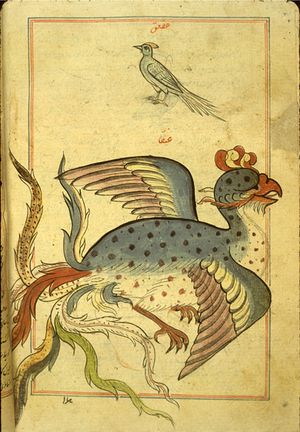「アンカ」の版間の差分
(→特徴) |
(→特徴) |
||
| 8行目: | 8行目: | ||
== 特徴 == | == 特徴 == | ||
| − | アンカは「非常に美しく、色鮮やかで、長い首、人間の顔、4対の翼<ref>"و في زمن موسى عليه السلام طائرة اسمها العنقاء لها أربعة أجنحة من كل جانب (.. in the time of Moses the bird named Al-Anqa having a four wings on either sides-->)</ref> | + | アンカは「非常に美しく、色鮮やかで、長い首、人間の顔、4対の翼<ref>"و في زمن موسى عليه السلام طائرة اسمها العنقاء لها أربعة أجنحة من كل جانب (.. in the time of Moses the bird named Al-Anqa having a four wings on either sides-->)</ref> 、あらゆる生物と何らかの類似性がある<ref>"و كانت العنقاء طائرة عظيمة الخلق، لها وجه إنسان، و فيها من كل حيوان شبه (..In it there were numerous birds one of which was the anqa, large in body, having a long neck, and a human face. it has some resemblance with every living being.--></ref>」とされ、首には「白さ」があるとされた<ref>Al-Farahidi-quote , والعَنْقاءُ: طائِرٌ لم يَبْقَ في أيدي الناس من صِفتها غيرُ اسمِها. ويقالُ بل سُمِّيَتْ به لبياضٍ في عُنقِها كالطَّوق. "Anqa: A bird that people no longer have any information about, but its name. It is said, it was rather named as such, because of some whiteness surrounding its neck as a collar."</ref><ref>=Lane Edward William , Arabic-English Lexicon , date:1863 , Cosimo Classics , London , isbn:9781616408985 , page:2244 , http://www.tyndalearchive.com/TABS/Lane// , access-date:3 October 2019</ref>。 |
2022年5月16日 (月) 01:33時点における版
アンカ(アラビア語:عَنْقَاء、ローマ字表記:ʾAnqāʾ)[1]、またはAnka、またはアンカ・ムーグリブ(Anqa Mughrib)、アンカ・アル・ムーグリブ(アラビア語:العَنْقَاء المُغْرِب、ローマ字表記:Anqa al-Mughrib)とも表記される。)[2]は、アラビア神話に登場する大きくて神秘的な、あるいは素晴らしい雌の鳥である。アンカは遠くまで飛び、何年かに一度しか現れないと言われている。しかし、アンカ「太陽が沈む場所」にも出没すると言われている[1]。
語源と注釈
アンカ(anqā)という言葉は、「首の長い」という意味の ʾaqnaq の女性形であり、「首が長くて太い」という意味でもある。これはおそらく、サギやツル(あるいは他の首の長い鳥)に似ている、あるいは単にワシやハヤブサ(あるいは他の猛禽類)のように大きな強い首を持っているという意味であり、アンカは一部でそれらの鳥と同一視されていたのだろう[1]。muḡribという言葉には、「奇妙な、外国の」「遠い、離れた」「西、日没」「荒涼とした、未知の」「白い、夜明け」などの意味があり、生物にまつわる謎や非現実を表現している。
しかしʿAnqāʾ、ʿはʾanāq(عناق「不幸、つらい出来事」)とも関係があり、muḡribとともに災難の意味で使われていた[1]。それは、この鳥はもともとすべて完璧に創られたが、疫病や災いとなり、殺されてしまったと言われているからである[3][4]。
特徴
アンカは「非常に美しく、色鮮やかで、長い首、人間の顔、4対の翼[5] 、あらゆる生物と何らかの類似性がある[6]」とされ、首には「白さ」があるとされた[7][8]。
Zakariya al-Qazwini in this cosmological book The Wonders of Creation comments about the anqa as "the kin of birds that lived alone on Mount Qaf" and "a wise bird with experience gained throughout many ages and gives admonitions and moral advice".[9] Qazwini also says that the bird lives for 1700 years, mating at 500 years of age and that the chick, after the egg breaks, stays inside and only comes out after 125 years.[9]
It is said that Anqa eats nothing except elephants and large fish.テンプレート:Efn
Identification
The anqa is frequently identified (to the point of becoming synonymous) with the simurgh of Persian mythology along with the Armenian and Byzantine eagles and the Turkic Konrul, also called semrük,[10] probably due to the sphere of influence of the Persian Empire.[11] It is also almost always glossed as a phoenix. In Turkish, the other name for the Konrul as well as a phoenix is テンプレート:Lang "the emerald anqa". In modern arabic Anqa is identified as a phoenix or griffin.
関連項目
- シームルグ
- フェニックス
- Chalkydri, bird hybrid creatures that live near the Sun alongside phoenixes from the Second book of Enoch
- ロック鳥, oc, another enormous legendary bird of Middle Eastern origin popularized in Arab folklore
- Anzû, a massive bird divinity or monster in Mesopotamian religion
- Konrul, also known as Zumrud Anka
- カフ山
参考文献
- Wikipedia:Anqa
Bibliography
- Wafayat al-aʼyan by Ibn Khallikan biography number 349
- Lisān al-ʿArab by Ibn Manzur part 10 page 276
- The Wonder of Creation by Zakariya al-Qazwini
- Kitab al-'Ayn by Al-Khalil ibn Ahmad al-Farahidi
Notes
参照
- ↑ 1.0 1.1 1.2 1.3 Lane Edward William , Arabic-English Lexicon , 1863 , Cosimo Classics , London ,isbn:9781616408985 , page2177 , http://www.tyndalearchive.com/TABS/Lane// , access-date:3 October 2019
- ↑ مُغْرِب , Mughrib) is the person who throw people down toward west or during sunset
- ↑ Phoenix (mythological bird) , https://www.britannica.com/topic/phoenix-mythological-bird#ref263489 , Encyclopedia Britannica , access-date:3 October 2019
- ↑ Abi Fadel , Marwan , Honouring the gods in the classical Mediterranean realm and on its fringes - The phoenix in Arab-Muslim sources , http://hemed.univ-lemans.fr/cours2012/en/co/grain5.html , hemed.univ-lemans.fr
- ↑ "و في زمن موسى عليه السلام طائرة اسمها العنقاء لها أربعة أجنحة من كل جانب (.. in the time of Moses the bird named Al-Anqa having a four wings on either sides-->)
- ↑ "و كانت العنقاء طائرة عظيمة الخلق، لها وجه إنسان، و فيها من كل حيوان شبه (..In it there were numerous birds one of which was the anqa, large in body, having a long neck, and a human face. it has some resemblance with every living being.-->
- ↑ Al-Farahidi-quote , والعَنْقاءُ: طائِرٌ لم يَبْقَ في أيدي الناس من صِفتها غيرُ اسمِها. ويقالُ بل سُمِّيَتْ به لبياضٍ في عُنقِها كالطَّوق. "Anqa: A bird that people no longer have any information about, but its name. It is said, it was rather named as such, because of some whiteness surrounding its neck as a collar."
- ↑ =Lane Edward William , Arabic-English Lexicon , date:1863 , Cosimo Classics , London , isbn:9781616408985 , page:2244 , http://www.tyndalearchive.com/TABS/Lane// , access-date:3 October 2019
- ↑ 9.0 9.1 テンプレート:Cite book
- ↑ テンプレート:Cite book
- ↑ SIMORḠ – Encyclopaedia Iranica.{{{date}}} - via {{{via}}}.
